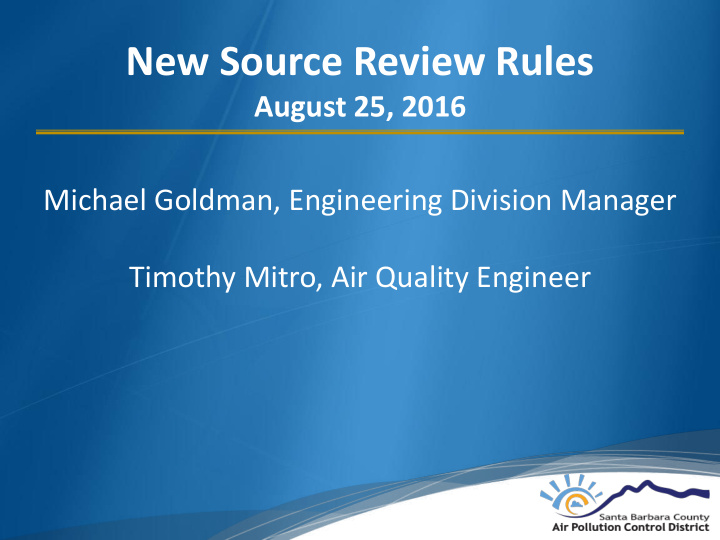



New Source Review Rules August 25, 2016 Michael Goldman, Engineering Division Manager Timothy Mitro, Air Quality Engineer
New Source Review • New Source Review (NSR) is an important tool to help the District attain and maintain all State and Federal ambient air quality standards • New Source Review – Criteria Pollutants • Nonattainment Review (NAR) • Prevention of Significant Deterioration (PSD) • Pre-construction permitting program for stationary sources — both new and modified • Does not apply to: motor vehicles, trains, planes, consumer products, pesticides and most agricultural operations. Includes some marine vessels. • 2-step process: 1) Authority to Construct (ATC) permit 2) Permit to Operate (PTO) permit
NSR Rule History • 1976 - District adopts first NSR regulation • 1984 - District modifies NSR regulation - adds PSD requirements • 1988 - District modifies NSR regulation - adds PM 10 as a pollutant • 1997 - District enacts significant revisions to NSR, creating Regulation VIII • 2016 - District proposes first revisions in nearly 20 years
Basic Components of NSR • There are State and Federal NSR program requirements, which the District implements in a unified permitting program • Best Available Control Technology (BACT) — State mandate • Air Quality Impact Analysis (AQIA) — Local and Federal mandate • Offsets — State mandate • Offsets are mitigation provided in the form of Emission Reduction Credits (ERCs) • Public Noticing and Hearings — Federal, State and Local mandate
Increasing Costs for ERCs
Proposed Rule Changes Objectives: • Safeguard the region’s air quality • Provide more flexibility and simplicity in the permitting process without compromising our air quality Proposed Changes: 1) Revise and clarify text 2) Simplify calculation methodologies 3) Revise offset threshold, trading ratios and calculation basis 4) Offsets exemption for functionally equivalent equipment replacements 5) Offsets exemption for emergency standby engines 6) Merge Rule 803 requirements (Local PSD) 7) Add PM 2.5 to permit system 8) Update Ambient Air Quality Standards (AAQS)/Increment Table 9) Add new Federal Minor Source NSR rule
Rulemaking Process • March 2014: Board direction • Next 16 Months: Worked extensively with California Air Resources Board (ARB) and United States Environmental Protection Agency (EPA) to ensure that the proposed changes met oversight agency requirements. • September 2015: Public Workshops • December 2015: District Community Advisory Council (CAC) meeting • April 2016: Draft Environmental Impact Report released • June/July 2016: ARB/EPA pre-adoption review period • August 2016: Board of Directors Hearing
Key Issues and Findings • Essential Public Services and Electrical Peaking Plant concepts dropped • No significant comments from the public or the regulated community • Questions about changing offset zones, ratios and thresholds • ARB comment period: No objections to the proposed rules • EPA comment period: No objections to the proposed rules. Minor requested changes to definitions. • EIR Findings: Impacts are Class III, Not Significant • Aspects of the project have clear, beneficial impacts
Staff Recommendations • Hold a Public Hearing and Receive Testimony on the proposed Rules/EIR • Adopt a Board Resolution approving the proposed Rules/EIR - Attachment 1 • Certify the Final EIR - Attachment 2 • Adopt the CEQA Findings - Attachment 3 • Adopt the H&SC Rule Findings - Attachment 4 • Adopt the Proposed Rules - Attachment 6
Questions?
Recommend
More recommend